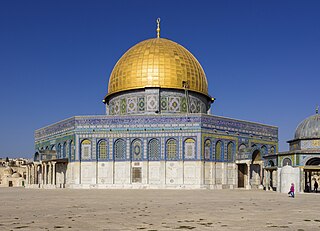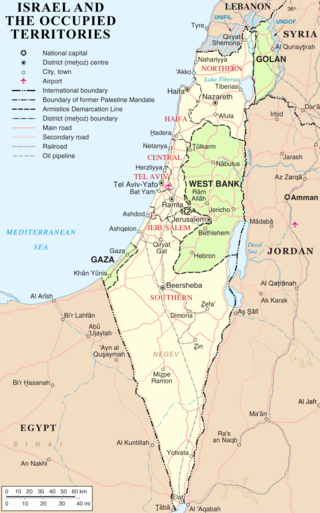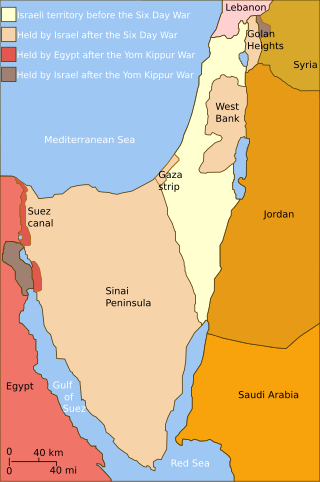
United Nations Security Council Resolution 242 (S/RES/242) was adopted unanimously by the UN Security Council on November 22, 1967, in the aftermath of the Six-Day War. It was adopted under Chapter VI of the UN Charter. The resolution was sponsored by British ambassador Lord Caradon and was one of five drafts under consideration.

The history of the State of Palestine describes the creation and evolution of the State of Palestine in the West Bank and Gaza Strip.

The 1949 Armistice Agreements were signed between Israel and Egypt, Lebanon, Jordan, and Syria. They formally ended the hostilities of the 1948 Arab–Israeli War and also demarcated the Green Line, which separated Arab-controlled territory from Israel until the latter's victory in the 1967 Arab–Israeli War.

The Camp David Accords were a pair of political agreements signed by Egyptian President Anwar Sadat and Israeli Prime Minister Menachem Begin on 17 September 1978, following twelve days of secret negotiations at Camp David, the country retreat of the President of the United States in Maryland. The two framework agreements were signed at the White House and were witnessed by President Jimmy Carter. The second of these frameworks led directly to the 1979 Egypt–Israel peace treaty. Due to the agreement, Sadat and Begin received the shared 1978 Nobel Peace Prize. The first framework, which dealt with the Palestinian territories, was written without participation of the Palestinians and was condemned by the United Nations.
The Beirut Summit was a meeting of the Arab League in Beirut, Lebanon, in March 2002 to discuss the Israeli–Palestinian conflict. At the time Yasser Arafat, the Leader of Palestine, was under house-arrest in his Ramallah compound. The Israeli forces confined him and prevented him from attending the Beirut Summit.

Intermittent discussions are held by various parties and proposals put forward in an attempt to resolve the ongoing Israeli–Palestinian conflict through a peace process. Since the 1970s, there has been a parallel effort made to find terms upon which peace can be agreed to in both the Arab–Israeli conflict and in the Palestinian–Israeli conflict. Notably the Camp David Accords between Egypt and Israel, which included discussions on plans for "Palestinian autonomy", but did not include any Palestinian representatives. The autonomy plan would not be implemented, but its stipulations would to a large extent be represented in the Oslo Accords.
The Arab League was formed in Cairo on 22 March 1945 with six members: Egypt, Iraq, Transjordan, Lebanon, Saudi Arabia, and Syria. Yemen joined on 5 May 1945. Since its formation the Arab League has promoted the Palestinian Arab cause in the Israeli–Palestinian conflict, including by imposing the Arab League boycott of Israel. The Arab League opposed the United Nations Partition Plan for Palestine in 1947. On 15 May 1948, the then seven Arab League members coordinated an invasion of what was by then the former British Mandate, marking the start of the 1948 Arab–Israeli War.
The International law bearing on issues of Arab–Israeli conflict, which became a major arena of regional and international tension since the birth of Israel in 1948, resulting in several disputes between a number of Arab countries and Israel.
The Madrid peace conference letter of invitation, also known as the Madrid Invitation or Letter of invitation to the Middle East Peace Conference in Madrid, of October 19, 1991, was a formal diplomatic invitation by the United States and the Soviet Union issued to Israel, Syria, Lebanon, Jordan and the Palestinians, calling on them to come together and hold a peace conference in Madrid, Spain. The resulting conference came to be known as the Madrid Conference that commenced on October 30, 1991.
The Green Line or 1949 Armistice border is the demarcation line set out in the 1949 Armistice Agreements between the armies of Israel and those of its neighbors after the 1948 Arab–Israeli War. It served as the de facto borders of the State of Israel from 1949 until the Six-Day War in 1967, and continues to represent Israel’s internationally recognized borders with the two Palestinian territories: the West Bank and the Gaza Strip.

Israel has occupied the Palestinian territories and the Golan Heights since the Six-Day War of 1967. It previously occupied the Sinai Peninsula and southern Lebanon as well. Prior to Israel's victory in the Six-Day War, occupation of the Palestinian territories was split between Egypt and Jordan, with the former having occupied the Gaza Strip and the latter having annexed the West Bank; the Sinai Peninsula and the Golan Heights were under the sovereignty of Egypt and Syria, respectively. The first conjoined usage of the terms "occupied" and "territories" with regard to Israel was in United Nations Security Council Resolution 242, which was drafted in the aftermath of the Six-Day War and called for: "the establishment of a just and lasting peace in the Middle East" to be achieved by "the application of both the following principles: ... Withdrawal of Israeli armed forces from territories occupied in the recent conflict ... Termination of all claims or states of belligerency and respect for and acknowledgment of the sovereignty, territorial integrity and political independence of every State in the area and their right to live in peace within secure and recognized boundaries free from threats or acts of force."

The Jarring Mission refers to efforts undertaken by Gunnar Jarring to achieve a peaceful settlement of the conflict between Israel and its Arab neighbors after the Six-Day War in 1967. He was appointed on 23 November 1967 by UN Secretary-General, U Thant, as Special Envoy under the terms of UN Security Council Resolution 242 to negotiate the implementation of the resolution.

The Allon Plan was a political proposition that outlined potential next steps for Israel after the 1967 Arab–Israeli War. It was drafted by Israeli politician Yigal Allon following Israel's seizure of territory from Syria, Jordan, and Egypt; the Israeli military had come to occupy Syria's Golan Heights, the Jordanian-annexed West Bank and the Egyptian-occupied Gaza Strip, and Egypt's Sinai Peninsula. Allon advocated a partitioning of the West Bank between Israel and Jordan, the creation of a sovereign state for Druze in the Golan Heights, and the return of most of the Sinai Peninsula to Egypt.
The Arab–Israeli conflict began in the 20th century, evolving from earlier Intercommunal violence in Mandatory Palestine. The conflict became a major international issue with the birth of Israel in 1948. The Arab–Israeli conflict has resulted in at least five major wars and a number of minor conflicts. It has also been the source of two major Palestinian uprisings (intifadas).

The three-line United Nations Security Council Resolution 338, adopted on October 22, 1973, called for a ceasefire in the Yom Kippur War in accordance with a joint proposal by the United States and the Soviet Union. The resolution stipulated a cease fire to take effect within 12 hours of the adoption of the resolution. The "appropriate auspices" was interpreted to mean American or Soviet rather than UN auspices. This third clause helped to establish the framework for the Geneva Conference (1973) held in December 1973.

The modern borders of Israel exist as the result both of past wars and of diplomatic agreements between the State of Israel and its neighbours, as well as an effect of the agreements among colonial powers ruling in the region before Israel's creation. Only two of Israel's five total potential land borders are internationally recognized and uncontested, while the other three remain disputed; the majority of its border disputes are rooted in territorial changes that came about as a result of the 1967 Arab–Israeli War, which saw Israel occupy large swathes of territory from its rivals. Israel's two formally recognized and confirmed borders exist with Egypt and Jordan since the 1979 Egypt–Israel peace treaty and the 1994 Israel–Jordan peace treaty, while its borders with Syria, Lebanon and the Palestinian territories remain internationally defined as contested.
Constructive ambiguity is a term generally credited to Henry Kissinger, said to be the foremost exponent of the negotiating tactic it designates. It refers to the deliberate use of ambiguous language on a sensitive issue in order to advance some political purpose. Constructive ambiguity is often disparaged as fudging. It might be employed in a negotiation, both to disguise an inability to resolve a contentious issue on which the parties remain far apart and to do so in a manner that enables each to claim obtaining some concession on it.
The Six-Day War was fought between June 5 and June 10, 1967, by Israel and the neighboring states of Egypt, Jordan, and Syria. The origins of the war include both longstanding and immediate issues. At the time of the war, the earlier foundation of Israel, the resulting Palestinian refugee issue, and Israel's participation in the invasion of Egypt during the Suez crisis of 1956 continued to be significant grievances for the Arab world. Arab nationalists, led by Egyptian President Gamal Abdel Nasser, continued to be hostile to Israel's existence and made grave threats against its Jewish population. By the mid-1960s, relations between Israel and its Arab neighbors had deteriorated to the extent that a number of border clashes had taken place.









